![]()
![]()
![]()
Use LEFT and RIGHT arrow keys to navigate between flashcards;
Use UP and DOWN arrow keys to flip the card;
H to show hint;
A reads text to speech;
55 Cards in this Set
- Front
- Back
|
Includes those organs whose primary function is theproduction of hormones or paracrines |
Endocrine System |
|
|
What organs does the Endocrine System include? |
Hypothalamus, pituitary gland, thyroid gland, adrenalgland, pancreas (pancreatic islets), pineal gland,parathyroid glands |
|
|
Many other organs contain tissues that secretehormones, but endocrine function is secondary |
Heart Thymus Digestive tract Kidneys Gonads |
|
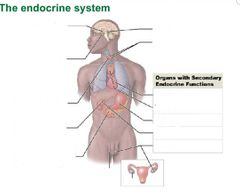
|
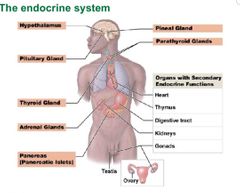
|
|
|
Secretes hormones involved in fluid balance, smoothmuscle contraction, control of hormone secretion byanterior pituitary gland |
Hypothalamus |
|
|
Secretes multiple hormones that regulate theendocrine activities of the adrenal cortex, thyroidgland, and reproductive organs, and a hormone thatstimulates melanin production |
Pituitary gland |
|
|
Secretes hormones affecting metabolic rate andcalcium ion levels in body fluids |
Thyroid gland |
|
|
• Secrete hormones involvedwith mineral balance, metabolic control, andresistance to stress• They also release epinephrine and norepinephrineduring sympathetic activation |
Adrenal glands |
|
|
Secretes hormones regulating rate of glucose uptake and utilization by body tissues |
Pancreas (pancreatic islets) |
|
|
Secretes melatonin, which affects reproductive function and circadian (day/night) rhythms |
Pineal gland |
|
|
Secrete hormone important to regulation of calcium ion levels in body fluids |
Parathyroid glands |
|
|
Blood volume |
Heart |
|
|
Immune response |
Thymus |
|
|
digestive function coordination,glucose metabolism, appetite |
Digestive tract |
|
|
• blood cell production • rate of calcium andphosphorus absorption by digestive tract • and an enzyme involved in regulating blood pressure |
Kidneys |
|
|
growth, metabolism, sexual characteristics as well as activities of organs in reproductive system |
Gonads |
|
|
To respond to a hormone, a target cell must have the appropriate protein _________. |
receptor Without the receptor, the circulating hormone has noeffect. |
|
|
______ have receptors for many different hormones. |
Cells |
|
|
Different combinations of receptors produce differentialeffects on _______ _______. |
specific tissues |
|
|
Receptor in plasma membrane |
Extracellular receptors |
|
|
Hormones affect target cells after binding to receptors in the ___________, ___________, or ___________. |
plasma membrane cytoplasm nucleus |
|
|
relaying message to an intracellular intermediary (second messenger) |
first messenger |
|
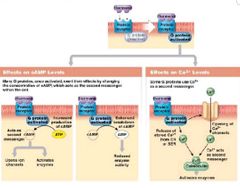
|
G protein- coupled receptors |
|
|
Examples of second messengers |
1. Cyclic AMP (cAMP) • Derivative of ATP • Increased levels may activate enzymes or open ionchannels, accelerating cell metabolic activity • Decreased levels has inhibitory effect on cell 2. Calcium ions (Ca2+) • Generally function in combination with intracellularprotein called calmodulin to activate enzymes. |
|
|
Two possible receptor locations on target cells |
1. Plasma membrane (extracellular receptors) 2. Cytoplasm or nucleus (intracellular receptors) |
|
|
affects enzyme activity andchanges cellular metabolic reactions, exertinghormone’s effects in the cell |
Second messenger |
|
|
(enzyme complex coupled to receptor) |
G protein |
|
|
Lipid-soluble hormones diffusethrough plasma membrane – Alter activity of specific genes – Affect DNA transcription rate,changing pattern of protein synthesis – Change synthesis of enzyme and structural proteins |
Steroid hormones |
|
|
•Transported across cell membrane by carrier-mediated processes – Bind to receptors on mitochondria • Increase rate of ATP production •Bind to receptors in nucleus• Activate specific genes orchange rate of transcription• Affects cell’s metabolicactivity and structure |
Thyroid hormones |
|
|
Provides highest level of endocrine function byintegrating nervous and endocrine systems |
Hypothalamus |
|
|
Three mechanisms of integration |
Antidiuretic hormone (ADH) Oxytocin (OXT) regulatory hormones |
|
|
Synthesized by the supraoptic nuclei |
Antidiuretic hormone (ADH) |
|
|
Synthesized by the paraventricular nuclei |
Oxytocin (OXT) |
|
|
control anterior pituitary gland endocrine cells |
regulatory hormones |
|
|
Capillary networks and interconnecting vessels between the hypothalamus and the pituitary gland(hypophysis, pituitary gland) |
Hypophyseal portal system |
|
|
Regulatory hormones released from the hypothalamus at the _______ _______ of infundibulum. |
median eminence |
|
|
Move from interstitial fluid into ______________. |
fenestrated capillaries |
|
|
Carried to anterior pituitary in ______________ (portal veins). |
Portal vessels |
|
|
Allows hypothalamic hormones to reach target cellsin anterior pituitary directly, without mixing anddiluting in general circulation |
Hypophyseal portal system |
|
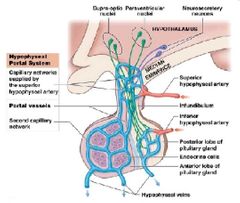
|
Hypophyseal portal system |
|
|
Stimulate synthesis and secretion of one or morehormones at anterior lobe |
Releasing hormones (RH) |
|
|
Prevent synthesis and secretion of one or morehormones at anterior lobe |
Inhibiting hormones (IH) |
|
|
•Small, oval gland nestled within sella turcica ofsphenoid bone •Releases nine peptide hormones Seven from anterior lobe (adenohypophysis) – Called tropic (trope, a turning) hormones because they “turn on” other endocrine glands • Two from posterior pituitary (neurohypophysis) • All nine bind to membrane receptors and use cAMP second messenger |
Pituitary gland, or hypophysis |
|
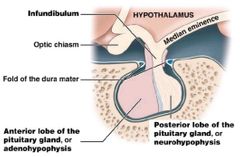
|
Pituitary gland |
|
|
• Thyroid stimulating hormone (TSH) • Adrenocorticotropic hormone (ACTH) • Follicle-stimulating hormone • Luteinizing hormone (LH) • Growth hormone (GH) • Prolactin • Melanocyte-stimulating hormone (MSH)
|
Hormones of the anterior lobe |
|
|
Hormones of the posterior lobe |
Antidiuretic hormone (ADH) *in the kidney
Oxytocin (OXT) *in the uterus |
|
|
• Targets the thyroid gland • Stimulates release of steroid hormones • Released in response to thyrotropin-releasing hormone (TRH) from hypothalamus • Release is decreased when thyroid hormone levels rise (negative feedback) |
Thyroid-stimulating hormone (TSH) |
|
|
• Stimulates release of steroid hormones from adrenal cortex (specifically those that affect glucose metabolism) • Released in response to corticotropin-releasing hormones (CRH) from hypothalamus |
Adrenocorticotropic hormone (ACTH) or corticotropin |
|
|
• Regulates activity of the gonads • Released in response to gonadotropin-releasing hormone (GnRH) from hypothalamus |
Gonadotropins |
|
|
F: promotes ovarian follicle development and (in combination w LH) stimulates secretion of estrogens M: promotes maturation of developing sperm Inhibited by inhibin (peptide released by gonads) |
Follicle-stimulating hormone |
|
|
F: induces ovulation, promotes secretion of estrogen and progesterone, prepares body for possible pregnancy
M: stimulates interstitial cells of testes to produce sex hormones (androgens), primarily testosterone
|
Luteinizing hormone (LH) |
|
|
Stimulates cell growth and reproduction by accelerating rate of protein synthesis – Skeletal muscle and chondrocytes are particularly sensitive to GH • Regulated by two hypothalamic hormones • Growth hormones can be direct or indirect |
Growth hormone (GH) |
|
|
Growth hormone is regulated by two hypothalamic hormones: |
– Growth hormone–releasing hormone (GH–RH) – Growth hormone–inhibiting hormone (GH–IH) |
|
|
Liver cells respond to GH by synthesizing and releasing ________. |
somatomedins |
|
|
What are somate |
compounds that stimulate tissue growth or insulin-like growth factors (IGFs) |

